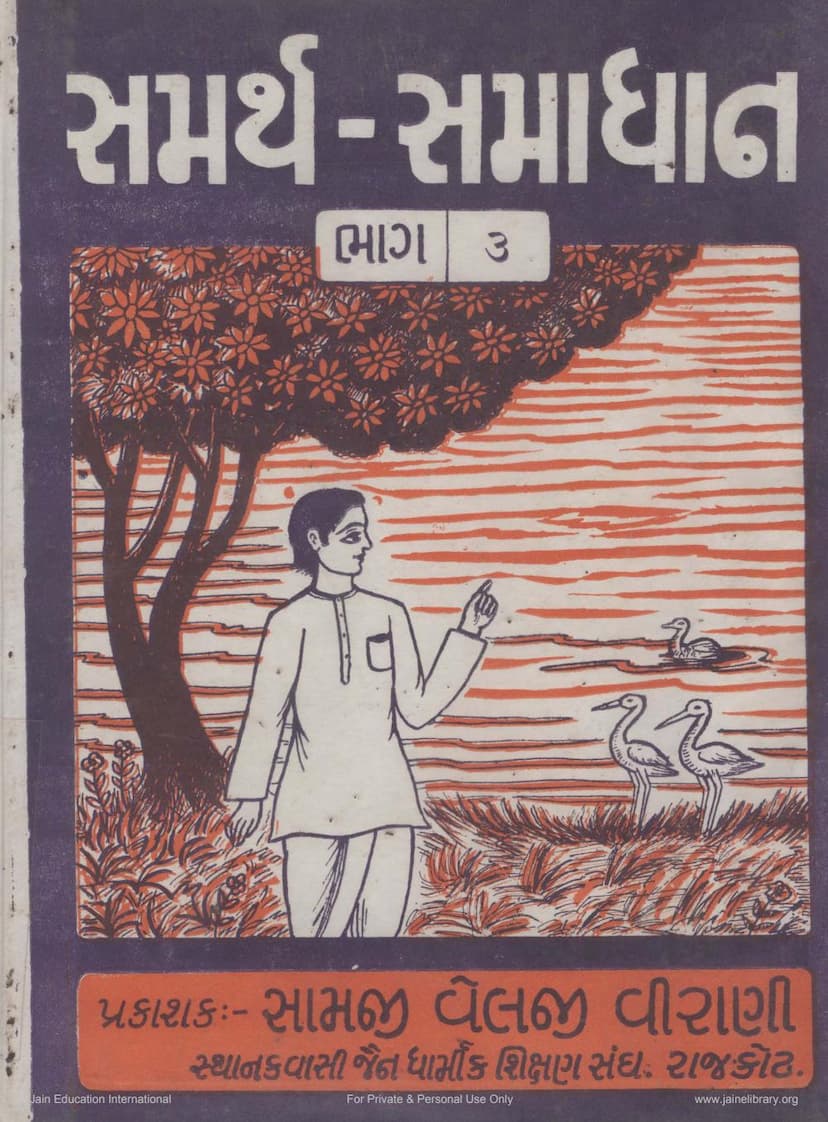Samarth Samadhan Part 3
Added to library: September 2, 2025

Summary
Here's a comprehensive summary of "Samarth Samadhan Part 3" by Samarthmal Maharaj, published by Sthanakwasi Jain Dharmik Shikshan Sangh Rajkot, based on the provided text:
Book Title: Samarth Samadhan Part 3 Author: Samarthmal Maharaj Publisher: Sthanakwasi Jain Dharmik Shikshan Sangh Rajkot
Overview:
"Samarth Samadhan Part 3" is the Gujarati translation of a series of books titled "Samarth Samadhan" originally written in Hindi. These books contain answers to numerous questions posed to the esteemed Samarthmal Maharaj, covering a wide spectrum of Jain philosophy, principles, practices, and scriptural interpretations. The publishing of this Gujarati edition is a significant effort by the Sthanakwasi Jain Dharmik Shikshan Sangh, Rajkot, aimed at disseminating Jain knowledge in an accessible language to a broader audience at a subsidized price. The book reflects a growing interest and awareness in religious matters within the Sthanakwasi Jain community, particularly noting the increased spiritual inclination of young girls and the number of learned women embracing the ascetic path.
Key Themes and Content:
The book is essentially a vast collection of questions and answers, spanning a multitude of topics relevant to Jainism. The catalog link provided (jainqq.org) offers a glimpse into the sheer volume and breadth of inquiries addressed in the book, with the provided text listing questions from number 1466 up to 2083. This indicates that the book delves deeply into complex doctrinal matters, scriptural nuances, and practical ethical dilemmas faced by followers.
Some of the prominent themes and areas covered, based on the questions listed, include:
- Metaphysical and Cosmological Concepts: Questions about the nature of matter (pudgals), their properties (sparks), time, space, celestial bodies (stars, sun, moon), different realms of existence (heavenly bodies, hells), and the structure of the universe (Jambudvipa, oceans).
- Spiritual Paths and Practices: Inquiries about different types of vows, ascetic practices, austerities (tapasya), meditation (dhyan), concentration (anupreksha), the nature of spiritual progress (gunasthan), liberation (moksha), and the qualifications for various spiritual stages.
- Scriptural Interpretation and Doctrine: A significant portion of the questions focuses on interpreting specific verses, concepts, and events from Jain scriptures like the Bhagavati Sutra, Uttaradhyayan Sutra, Sthananga Sutra, Nandi Sutra, Kalpa Sutra, and others. This includes debates on the authenticity of texts, the meaning of specific terms, the chronology of events, and the reconciliation of apparent contradictions.
- Ethical and Practical Conduct: The book addresses questions related to the daily conduct of monks and nuns, as well as lay followers (shravaks and shravikas). This includes issues of food ethics (consumption of certain vegetables, usage of certain ingredients), acceptable behavior in various situations, the implications of touching or interacting with the opposite sex, the importance of adherence to vows, and the principles of charity and donation.
- Theological and Philosophical Debates: The text engages with questions about the nature of deities, the worship of celestial beings, the concept of divine intervention, the validity of various philosophical viewpoints (including comparisons with other religious traditions like Buddhism), and the attributes of various spiritual beings and souls.
- The Nature of Karma and Rebirth: Numerous questions likely explore the intricacies of karma, its types, bondage, fruition, and the process of transmigration of the soul across different life forms and realms. The concepts of life-span (ayushya), its binding and its modification are also likely covered.
- The Role of Ascetics and Laypeople: The book touches upon the duties and responsibilities of both ascetics (monks and nuns) and lay followers, their spiritual journey, and the importance of knowledge and action in achieving spiritual goals.
- Historical and Biographical Queries: Questions about the lives of Tirthankaras, spiritual leaders, kings, and historical figures within the Jain tradition are likely present, seeking clarification on their actions, motivations, and spiritual attainments.
Publisher's Intent and Community Context:
The Sthanakwasi Jain Dharmik Shikshan Sangh, Rajkot, by publishing this work, demonstrates its commitment to furthering Jain education. The organization's goal, as stated, is to instill religious values in children and ensure the future generation of Jain followers leads a meaningful life. The affordable pricing further underscores their dedication to making this knowledge accessible to all. The book also highlights the active participation and spiritual dedication observed within the Sthanakwasi Jain community, particularly among women and young girls.
Overall Significance:
"Samarth Samadhan Part 3" serves as a valuable resource for anyone seeking a deeper understanding of Jainism. It addresses a vast array of questions, providing insights into the complexities of Jain philosophy and practice as expounded by Samarthmal Maharaj. The book stands as a testament to the enduring quest for knowledge and spiritual growth within the Jain tradition, and the dedication of organizations like the Sthanakwasi Jain Dharmik Shikshan Sangh in preserving and propagating this rich heritage.